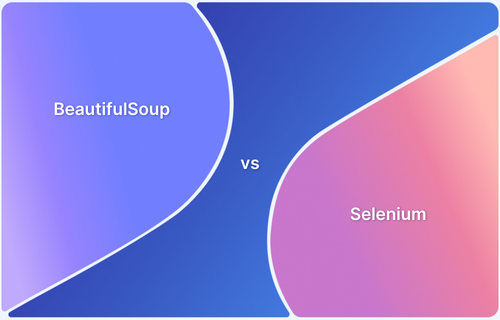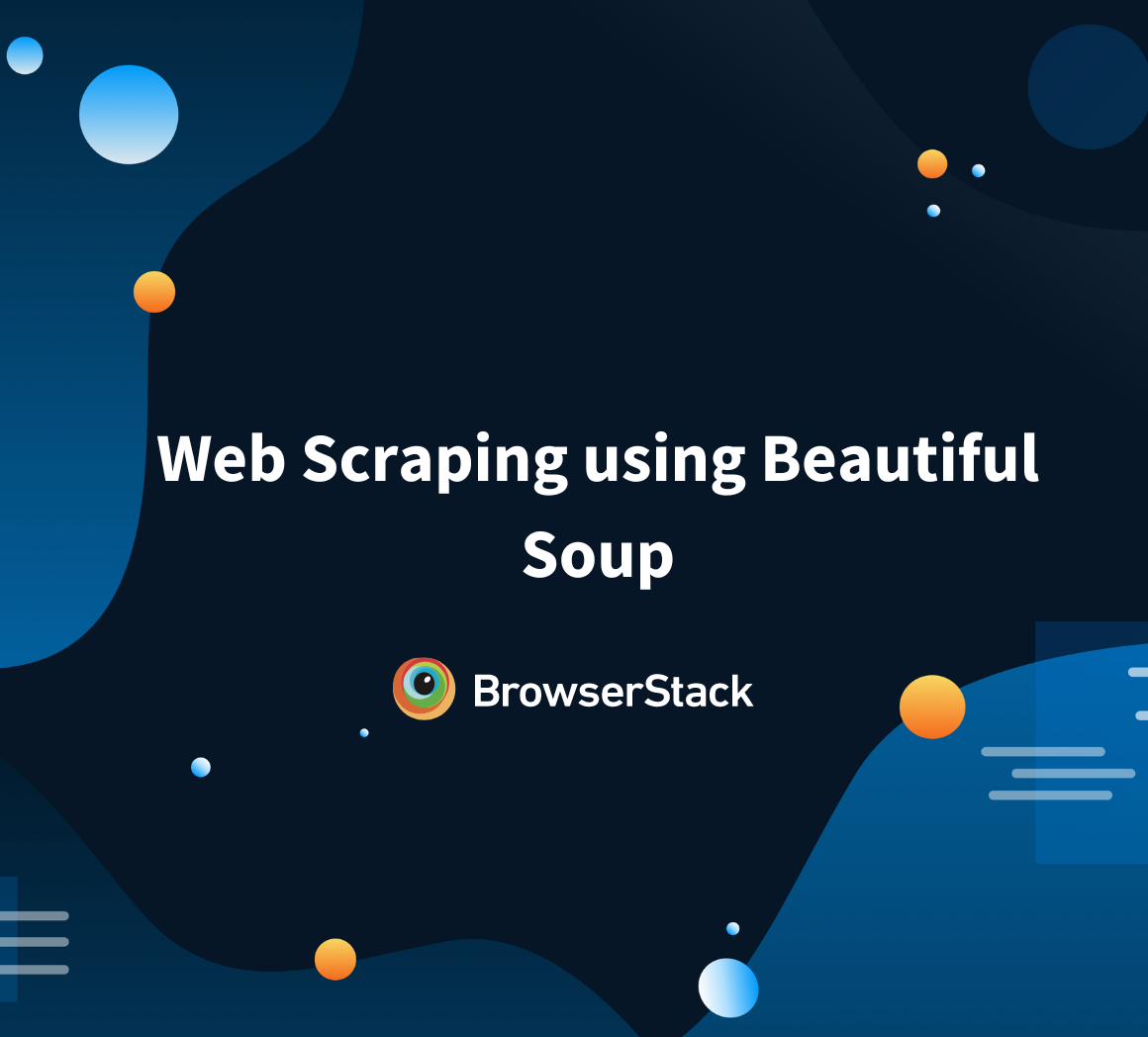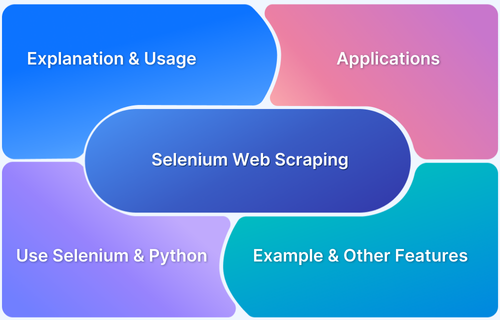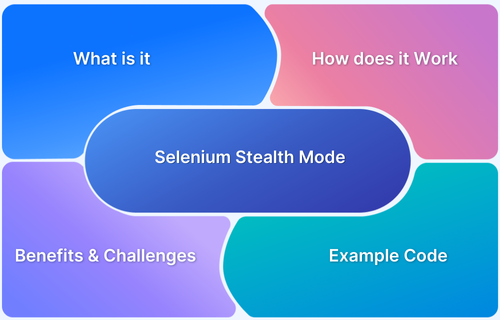BeautifulSoup and Selenium are popular tools for web scraping and automation, each offering distinct advantages and suited to different scenarios.
Overview
What is Selenium?
Selenium is a powerful web automation tool that interacts with web browsers, enabling tasks like testing, scraping, and simulating user behavior.
What is BeautifulSoup?
BeautifulSoup is a Python library for parsing and extracting data from HTML or XML documents, ideal for lightweight and simple web scraping tasks.
Which to Choose?
Choose Selenium for dynamic, JavaScript-heavy websites requiring interaction. Opt for BeautifulSoup for fast, lightweight scraping of static web pages.
This article explores the differences between these tools, shedding light on their strengths, limitations, and when to use each one so that you can make the best choice for your web scraping or automation projects.
What is BeautifulSoup?
BeautifulSoup is a Python library used for parsing and navigating the content of web pages written in HTML or XML.
It creates a “parse tree” that simplifies locating and extracting specific elements from a page, such as headings, tables, or images. It is highly flexible, works well with parsers like html.parser and lxml, and is a popular choice for automating tasks or gathering data from the web.
Read More: Web Scraping using Beautiful Soup
Example use case of BeautifulSoup
Let’s say you’re researching news trends and need the latest headlines, BeautifulSoup can automatically extract them, saving you time and effort, especially with large datasets.
Code example for using BeautifulSoup to extract data
Here’s a quick example to show how BeautifulSoup can extract all the links from a web page:
from bs4 import BeautifulSoup import requests # Get the web page content url = "https://example.com" response = requests.get(url) # Parse the HTML using BeautifulSoup soup = BeautifulSoup(response.content, 'html.parser') # Find and print all the links for link in soup.find_all('a'): print(link.get('href'))
In this example, the code fetches the web page, parses it, and then prints out all the hyperlinks it finds. It’s a simple way to collect data without needing to comb through the code manually.
Pros
Here are the pros of using BeautifulSoup:
- Easy to learn: The syntax is straightforward, even for beginners.
- Flexible: You can use it with different parsers and handle HTML or XML content.
- Integrates well: It works perfectly with tools like Requests to fetch web pages.
- Great community support: There are plenty of tutorials and examples to help you get started.
Cons
Here are the cons of using BeautifulSoup
- Not the fastest: It’s slower compared to other tools when handling big websites.
- Dependent on structure: If a website changes its layout, your script may stop working.
- Limited capabilities: BeautifulSoup is mainly for parsing, not for managing advanced web scraping tasks.
- Ethical concerns: You need to make sure you’re following the website’s rules and scraping responsibly.
What is Selenium?
Selenium is a browser automation tool that simulates real user interactions with web pages. It’s perfect for tasks like clicking buttons, scrolling, filling out forms, and even testing web applications.
Selenium is especially useful for websites that update their content dynamically using JavaScript, making it an essential tool for scraping data from such pages or automating complex workflows.
Example use case of Selenium
Assume you’re collecting reviews or prices from an e-commerce site with dynamic content, Selenium lets you simulate interactions like clicking or waiting for data to load, making it ideal for handling sites where simpler tools don’t work.
Code example for using Selenium to gather product titles from a webpage
from selenium import webdriver from selenium.webdriver.common.by import By from selenium.webdriver.chrome.service import Service from selenium.webdriver.support.ui import WebDriverWait from selenium.webdriver.support import expected_conditions as EC # Configure WebDriver service = Service('/path/to/chromedriver') # Update this to the correct path of chromedriver options = webdriver.ChromeOptions() options.add_argument("--headless") # Run in headless mode (no GUI) for efficiency, especially in CI/CD pipelines options.add_argument("--disable-gpu") # Disable GPU to avoid rendering issues in headless mode options.add_argument("--no-sandbox") # Necessary for certain environments like Docker containers options.add_argument("--disable-dev-shm-usage") # Useful in Docker to prevent shared memory issues # Optionally, you can use Remote WebDriver if the browser is hosted remotely or for grid testing # from selenium.webdriver.remote.webdriver import WebDriver # remote_driver = webdriver.Remote( # command_executor='http://remote-webdriver-server:4444/wd/hub', # Update with the actual URL of the remote WebDriver server # options=options # Pass ChromeOptions or other browser options # ) driver = webdriver.Chrome(service=service, options=options) try: # Open the webpage driver.get('https://example.com') # Wait for product titles to load wait = WebDriverWait(driver, 10) # Wait for up to 10 seconds products = wait.until( EC.presence_of_all_elements_located((By.CLASS_NAME, 'product-title-class')) # Replace with the actual class name ) # Print each product title for product in products: print(product.text) finally: # Close the browser driver.quit()
This example uses explicit waits to ensure that the content is fully loaded before trying to extract it. It’s a clean and efficient way to scrape data from dynamic sites.
Pros
Here are the pros of using Selenium
- Handles Dynamic Content: Works well with websites that rely on JavaScript.
- Simulates User Actions: Capable of tasks like clicking, typing, and scrolling.
- Cross-Browser Support: Compatible with Chrome, Firefox, Edge, and more.
- Wide Application: Ideal for testing, scraping, and automating web-based workflows.
Cons
Here are the cons of using Selenium
- Slower Performance: Not as quick as other tools for static pages.
- Setup Complexity: Requires a WebDriver and proper configuration.
- Resource Intensive: Uses more memory and CPU, especially for extended tasks.
- Prone to Breakage: Scripts may fail if the website’s structure changes.
Installation and Setup
BeautifulSoup and Selenium serve different purposes but are both essential for web scraping and automation. BeautifulSoup is easy to install and requires minimal setup, primarily for parsing HTML and XML.
Selenium, on the other hand, involves additional steps, including downloading browser drivers for automation.
This section covers the straightforward installation and setup process for BeautifulSoup and Selenium-Python.
BeautifulSoup
Follow these step-by-step instructions to install and set up BeautifulSoup:
Step 1. Ensure Python is installed on your system.
Step 2. Install BeautifulSoup via pip:
pip install beautifulsoup4Step 3. (Optional) Install lxml for better parsing performance:
pip install lxmNote: lxml is often faster than the default html.parser, but it’s optional for basic usage.
Step 4. BeautifulSoup is now ready to use, and no additional setup is required.
Selenium
Follow these step-by-step instructions to install and set up Selenium:
Step 1. Ensure Python is installed on your system.
Step 2. Install Selenium via pip:
pip install seleniumStep 3. Download the appropriate WebDriver for your browser:
Step 4. Place the WebDriver in a directory included in your system’s PATH, or specify its location directly in your script.
Step 5. (Optional) For cloud-based testing, you can sign up for services like BrowserStack and configure WebDriver with your credentials for cross-browser automation.
These steps should guide you through setting up both BeautifulSoup and Selenium for web scraping and browser automation.
Key Differences Between BeautifulSoup and Selenium
When deciding between BeautifulSoup and Selenium for web scraping or automation, it’s essential to understand their unique capabilities and limitations.
While both tools are effective, they serve different purposes based on the nature of the content being scraped and the complexity of the task.
Here’s a comparison of their key differences:
| Feature | BeautifulSoup | Selenium |
|---|---|---|
| Static vs. Dynamic Content | Best for scraping static content from HTML or XML documents. | Handles both static and dynamic content, including pages with JavaScript rendering. |
| Speed and Performance | Faster for static pages due to its lightweight nature. | Slower, as it interacts with browsers and renders JavaScript. |
| Complexity | Simple to use and lightweight, ideal for basic scraping tasks. | More complex, requiring setup of WebDriver and interaction with browsers. |
| Browser Interaction | Does not interact with browsers; works with parsed HTML. | Fully interacts with browsers, simulating user actions. |
| Integration and Compatibility | Compatible with libraries like requests for fetching HTML. | Compatible with various browsers and cloud services like BrowserStack for cross-browser testing. |
Which to Choose: Selenium vs. BeautifulSoup?
Choosing between Selenium and BeautifulSoup depends on what you’re trying to achieve.
If you’re working with static web pages and just need to extract data, BeautifulSoup is the way to go. It’s lightweight, fast, and simple to use.
However, if you need to interact with dynamic content or automate tasks like filling out forms, clicking buttons, or handling JavaScript, Selenium is a better fit. Plus, when paired with BrowserStack, Selenium provides even more powerful features for testing across browsers, on real devices, and with parallel test execution.
Advantages of using Selenium with BrowserStack Automate
Using Selenium in combination with BrowserStack Automate enhances the power of web automation by offering seamless cross-browser and real-device testing. It enables more efficient, scalable testing, ensuring your scripts work across various environments and devices. Have a look at the pointers below for an in-depth analysis.
- Cross-Browser Testing: BrowserStack makes it easy to run your Selenium scripts across various browsers and their different versions. This ensures that your automation works consistently, no matter which browser your users prefer. With BrowserStack, you can test on the latest versions of Chrome, Firefox, Safari, and Edge without the hassle of maintaining complex local browser setups.
- Real-Device Testing: When using Selenium with BrowserStack, you can take your testing to real devices, not just simulators. This means you can test your web application on actual Android and iOS devices, mimicking real-world conditions to catch issues that may not appear in desktop environments.
- Parallel Test Execution: BrowserStack’s ability to run Selenium tests in parallel drastically speeds up the testing process. Instead of running tests one by one, you can execute multiple tests at once across different browsers and devices. This helps you get faster feedback, especially for larger-scale automation projects that need comprehensive testing across many environments.
BeautifulSoup is perfect for simple web scraping tasks, while Selenium is ideal for dynamic websites and automation. When paired with BrowserStack, Selenium gives you the added benefits of cross-browser, real-device, and parallel testing, making it a powerful tool for comprehensive web automation.
Use Case Example: Scraping Dynamic Content with Selenium & BrowserStack Automate
When scraping dynamic content, like data rendered by JavaScript, Selenium combined with BrowserStack Automate offers a robust solution. BrowserStack enables you to test your scraping script across different browsers and real devices, ensuring consistent performance across various environments.
Example of How to Configure Selenium with BrowserStack Automate for Scraping Dynamic Content Across Multiple Browsers and Devices:
1. Sign up for BrowserStack and get your access credentials (username and access key).
2. Install necessary dependencies:
pip install selenium webdriver-manager
3. Set up BrowserStack Integration in your Selenium script. Below is the updated Python code for scraping dynamic content using Selenium with BrowserStack Automate:
Sample Code:
from selenium import webdriver from selenium.webdriver.common.by import By from selenium.webdriver.chrome.options import Options from webdriver_manager.chrome import ChromeDriverManager import time # BrowserStack credentials username = "your_browserstack_username" access_key = "your_browserstack_access_key" # BrowserStack capabilities desired_cap = { 'browser': 'Chrome', 'browser_version': 'latest', 'os': 'Windows', 'os_version': '10', 'name': 'Selenium BrowserStack Test', # Test name 'build': 'Build 1', # Build name } # Initialize WebDriver with BrowserStack credentials chrome_options = Options() chrome_options.add_argument("--headless") # Headless mode chrome_options.add_argument("--disable-gpu") chrome_options.add_argument("--no-sandbox") # Set up the driver using WebDriverManager driver = webdriver.Remote( command_executor=f"https://{username}:{access_key}@hub-cloud.browserstack.com/wd/hub", desired_capabilities=desired_cap, options=chrome_options ) # Open the dynamic content page driver.get("https://yourwebsite.com/dynamic-content") # Wait for the dynamic content to load time.sleep(5) # Scrape the dynamic content (Example: Get a list of items from a dynamically rendered table) items = driver.find_elements(By.CLASS_NAME, "dynamic-item-class") for item in items: print(item.text) # Example of interaction (clicking a button to load more content) load_more_button = driver.find_element(By.ID, "load-more-button") load_more_button.click() # Wait for additional content to load time.sleep(5) # Scrape the newly loaded content new_items = driver.find_elements(By.CLASS_NAME, "dynamic-item-class") for new_item in new_items: print(new_item.text) # Close the browser after scraping driver.quit()
This example ensures your dynamic content scraping works efficiently across different browsers and devices.
Challenges of Combining BeautifulSoup and Selenium
Combining BeautifulSoup and Selenium can be effective, but it presents several challenges:
- Complexity: BeautifulSoup excels with static content, while Selenium is designed for dynamic content. Using both together requires careful management of their interactions, which can complicate your script.
- Performance: Selenium is slower than BeautifulSoup since it interacts with an actual browser. When combined, this can result in slower scraping, as Selenium must load pages before BeautifulSoup parses the content.
- Resource-Intensive: Selenium uses more system resources because it runs a real browser. Running both tools together can lead to higher memory and CPU usage, particularly for large-scale scraping tasks.
- Error Handling: Selenium can face issues like page load failures or JavaScript execution problems, which can affect the entire scraping process. Managing these errors can be more challenging than when using BeautifulSoup alone.
- Debugging: Debugging combined scripts is more complicated because errors could originate from either BeautifulSoup or Selenium, making it harder to pinpoint the exact cause of issues.
Conclusion
When choosing between BeautifulSoup and Selenium, the decision largely depends on the requirements of the web scraping or automation task. Both BeautifulSoup and Selenium have their strengths and are suited to different use cases.
- BeautifulSoup is ideal for static pages and simple scraping tasks, offering speed and efficiency.
- Selenium is better for dynamic content or tasks requiring user interaction, like form submission or clicking buttons.
For tasks involving both static and dynamic content, combining the two is possible but adds complexity.
For large-scale automation, Selenium with BrowserStack offers powerful cross-browser and real-device testing capabilities. However, for simpler scraping, BeautifulSoup is the more efficient option.






